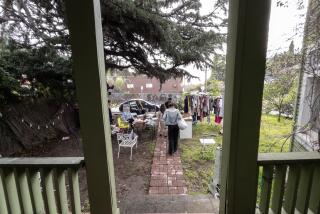The real gentrification story
The Times’ recent article on gentrification in Echo Park, like all of its kind, missed one fundamental truth: Gentrification starts, historically and consistently, when the original property owners -- regardless of ethnic origin -- realize that their property has appreciated (a lot) and freely choose to sell and get out of their quaint urban neighborhoods. Even when no real estate appreciation is involved, these homeowners flee to the safety and prestige of the suburbs or “posh” urban areas once they become financially successful.
There are many well-heeled minorities living in Beverly Hills, Pasadena, San Marino and the whiter suburbs behind the Orange Curtain. They elected to “sell out” and abandon their neighborhoods either for (huge) financial gain, better public schools or what they regarded as an improvement of lifestyle. They were not forced out. Instead of buying the house they used to rent and fixing it up, adding to it or buying a bigger one in the same ‘hood, they cashed out, packed up and left.
As a practicing architect for over 20 years, I have time after time witnessed this consistent exodus of the first or second generation of immigrants, as well as working-class Anglos, as soon as their income and/or equity rose. The Mexican interior designer who left East L.A. for Beverly Hills; the Korean builder who transitioned from, yes, Koreatown to Westwood; the Salvadoran body shop owner who moved from Highland Park to Hacienda Heights; the Lebanese software developer who went from Long Beach to Brentwood; the Cuban attorney who now lives in Linda Vista; the Greek restaurant magnate now in San Marino. In fact, among my several friends and clients, I know one, and only one, family that kept their old home in Echo Park after they made enough money to move to Bel Air. None of those people was strong-armed to sell, and certainly none was prevented from buying another property in the neighborhood where they had started out.
What about the anti-gentrification neighborhood activists who want us to believe that profit-driven developers are driving out natives? Again, based on my empirical, firsthand experience, the majority of these activists fall into one of the following groups:
1. The non-working and well-heeled, younger or retired, who have no financial worries and make activism the front and center of their existence. In their life of leisure, activism is the most exciting part of their day. The most dangerous of these? Retired attorneys who terrorize everyone in their path by showing off the rhetoric and pompousness they once used in court.
2. The struggling and non-working by choice. This group thrives primarily in Los Angeles and New York and includes aspiring screenwriters, producers and actors (of course). Several members of this group voluntarily abandoned their money-making careers in pursuit of their dream; during that pursuit, they need to cut their living expenses to a minimum, and rent-controlled, run-down housing in an up-and-coming neighborhood is a numero uno priority. Again from firsthand experience, this group counts several attorneys who quit law to pursue writing careers -- and one more who is an aspiring stand-up comedian. Sure, I am subsidizing my own daughters while they are studying or pursuing their dream; but I refuse to subsidize any other self-absorbed adult who quits his job to spend six hours every day at the local cafe abusing his laptop and developing bad coffee breath.
3. The well-heeled professionals who obsess with living in rent-controlled apartments as a sign of shrewdness. Even though their number has dwindled in the last few years, they still thrive, primarily in Santa Monica. It is a point of immense pride for a six-figure-salaried professional to pay $500 rent on digs right on Montana and 3rd Street.
4. Last, but not least, there are indeed working-class families that benefit hugely from rent control. I confess that I had to relocate such a family a few years ago in Silver Lake. I voluntarily offered them a fee far and above what rent-control law required, enough for a down payment on a small house or to start the kids’ college fund. The family was ecstatic to receive the relocation money: They moved to a rental in East L.A. and bought a brand spanking new Toyota Sequoia.
One final thought: During my undergraduate studies in another country eons ago, I read a textbook by a British urban planner that left an indelible mark in my young and impressionable mind. He offered a brilliant explanation of why in the U.S. people are so obsessed with grass-roots organizations, neighborhood councils and local government, while historically they vote in pitifully low numbers during elections, presidential and otherwise: Those in power, whether they are called Big Brother, the capital, the establishment, Chevron or Halliburton, encourage the busy-bodies to be involved in local matters so that their attention is diverted from issues of national and foreign policy. In other words, stay busy trying to block a new condo and fighting gentrification and leave the serious business of how to run the country to us. Makes absolutely perfect sense to me.
Lazaros Papademetropoulos received his master’s in architecture and urban planning from UCLA, and has been an architect in Los Angeles since 1984.
Blowback is an online forum for full-length responses to our articles, editorials and Op-Eds. Click here to read more about Blowback, or submit your own by e-mailing us at opinionla@latimes.com.
More to Read
A cure for the common opinion
Get thought-provoking perspectives with our weekly newsletter.
You may occasionally receive promotional content from the Los Angeles Times.






